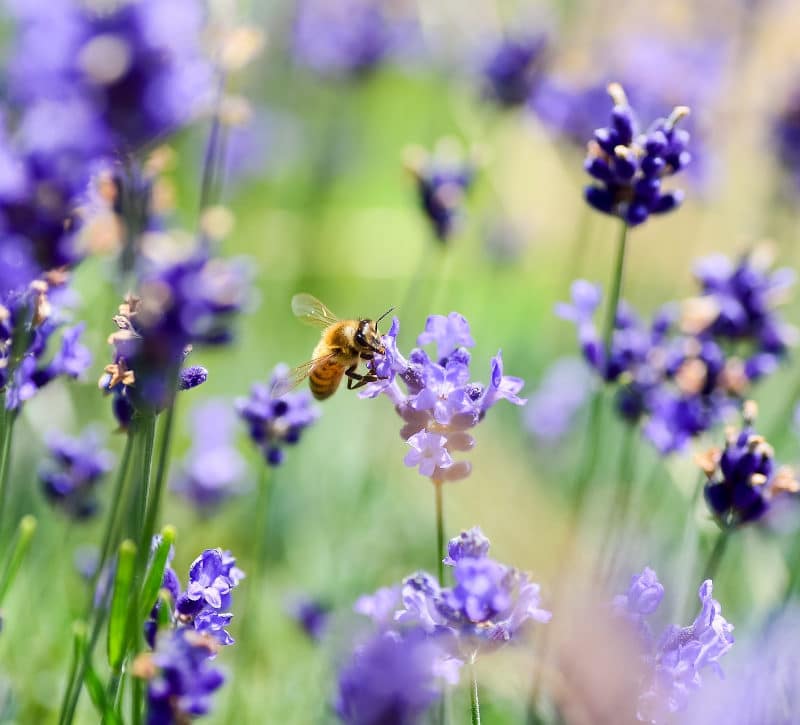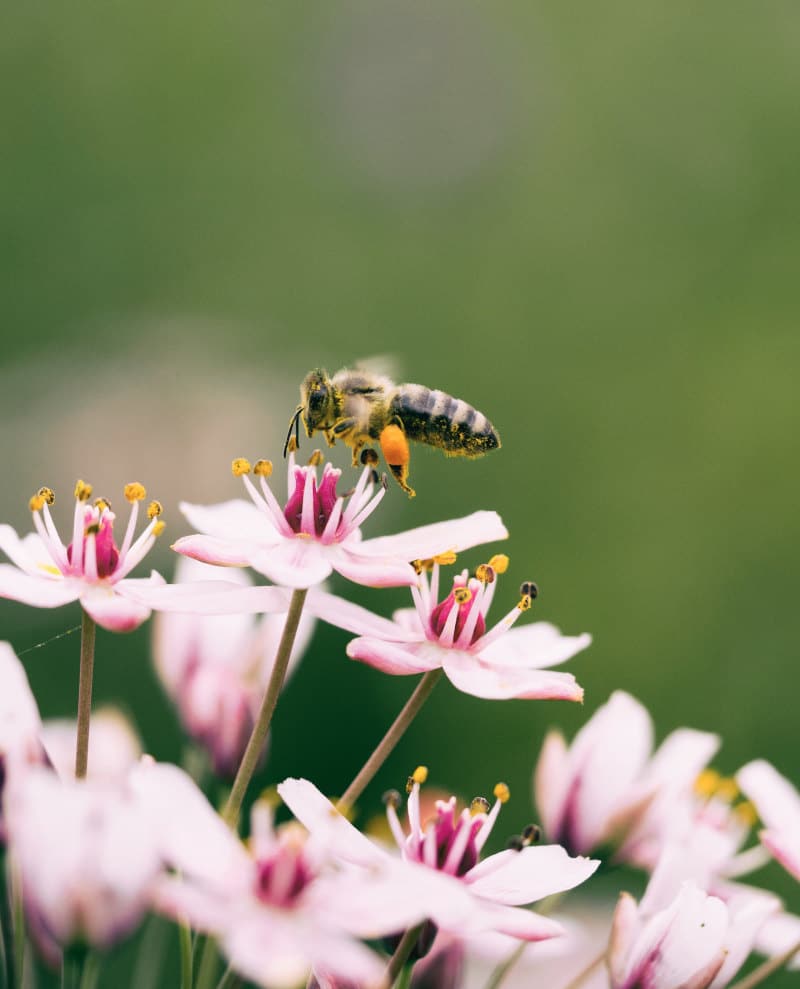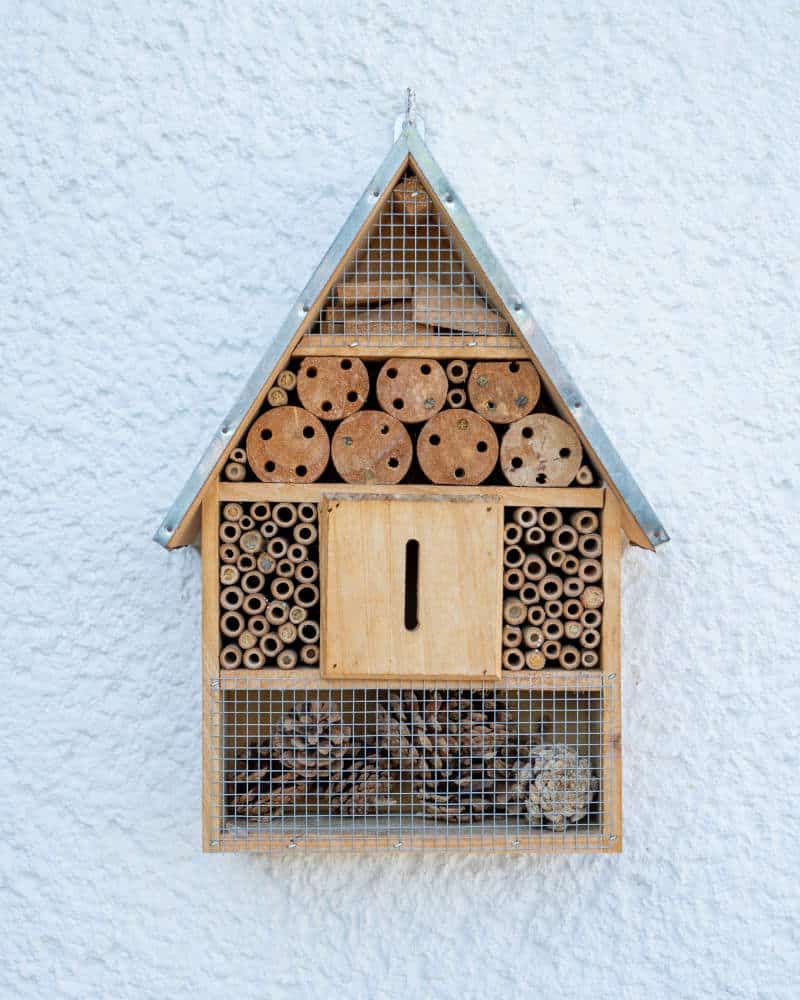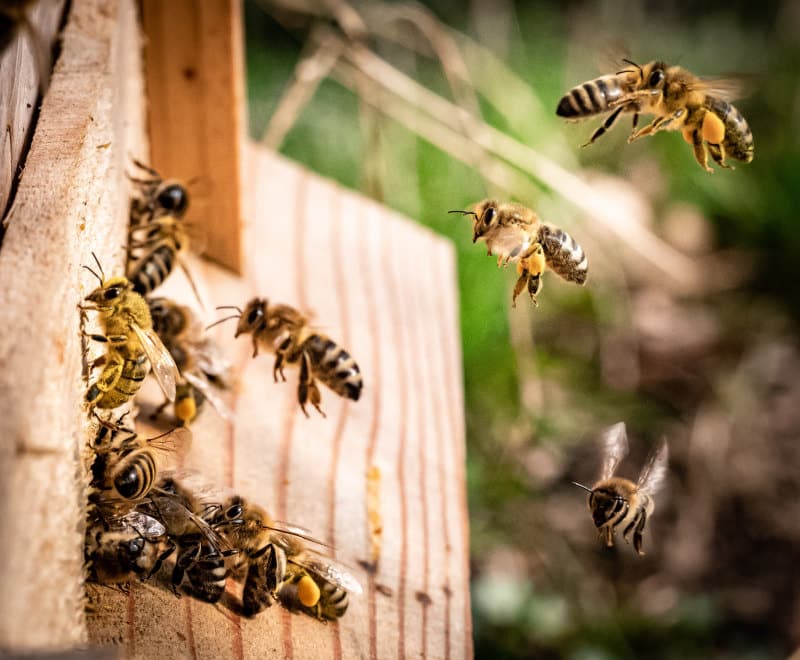Bee Gardens: How to Create a Sustainable Bee-friendly Garden
Bee-friendly gardens packed with flowers and plants that bees like are one of the easiest ways we can do ourselves to help save the bees. These little critters are so important to the natural and healthy maintenance of many of our ecosystems.
However, our bees are struggling.
Bee populations have been slowly declining over the years. This decline could be to do with increased pollution, our usage of pesticides, or some illness we have yet to discover. Whatever it is that is killing our precious bees we have to make life easier for them.
Without the bees, many of our fruits, vegetables, flora, and fauna would struggle to pollinate and we could be left with a world void of the colour and vegetation we are used to.
So, let’s give the bees their habitats back by following our steps to create a sustainable bee garden – gardens that are hot spot destinations for the large number of bee species that pollinate our plants.
If you have been wondering how to create a bee garden, you are in the right place. This guide will give you all the knowledge you need to create the best bee garden for our fuzzy, buzzy friends.
Is It Good To Have Bees In Your Garden?
Yes, having bees in your garden is more than good, it is necessary. Many of the plants in your garden are an important food source for our bees.
However, our bees also have an important role to play with our plant’s pollen by pollinating our plants.
If you have watched the bees going from flower to flower in your garden, you may have wondered what they are doing. Well, they are collecting food for their hives. Unless they are solitary bees and then they are just going to town on your colourful buffet.

Bees visit flowers for two types of nutrients. Nectar is the main source of energy for bees in our gardens. It is loaded with natural sugars, which gives our bees a much-needed energy hit to support their busy lives. Nectar is also one of the vital parts of a bee’s diet.
Pollen is the second food source bees gather from our flowering plants. Pollen is full of all the protein and fat that bees need to maintain a healthy diet.
However, it is the pollen that gives the bees an important role in the food chain. Every time a bee visits a flower, they get covered in pollen and once they bury deep into another flower they begin to spread this pollen from one female plant to another.
It is this cross-pollination that keeps our plants seeding and growing anew.
So, without bees in your garden, your plants and flowers would not live very long and they would not be able to seed new versions of themselves.
What Is A Bee Garden?
A bee garden is a space catered to the needs of bees. You don’t need to dedicate your entire garden to creating a bee garden, a roomy corner will do.
It is no groundbreaking news when I tell you that the natural habitat for bees has dramatically reduced over the years. This decline in habitat hasn’t helped the decline of bee populations all over the world.
A bee garden is a place we can all create to help give the bees shelter, food, water, and rest. If you have watched the bees, you will know they are busy and always on the move. This high-energy lifestyle requires lots of food and rest but with the decline of habitats and food sources, our bees are struggling.
This is why everyone, who has the space, should create a small garden full of bee-friendly plants and flowers, freshwater (here are some excellent water-saving tips), and shade, to give our precious bees the respite they need.
How To Start A Bee Garden
Starting a bee garden is incredibly easy. If you can dedicate your entire garden space to your bee garden, that is amazing, but if you can only use a small part of it for the bees, that is totally ok too. The bees aren’t fussy. They will be happy with a little nourishment and rest.
Once you have decided where your bee garden is going to be, you will need to start collecting all the bits you need to make this a haven for our bee friends.
You will need some bee-friendly plants and flowers, or you can grow these plants from seed if you have the time and patience. Your bee garden will also need a freshwater source because bee life is thirsty work and you will also need to create little pockets of shade.
But what if you don’t have a garden at all? Many of us live in apartment buildings or other homes that just don’t have any garden space. Don’t worry, you can still help create a bee garden. You will just need to use a little imagination.

Hanging basket plants are an excellent way of introducing some bee-friendly and nutrient-rich plants to your home without needing any floor space. If you have a balcony, you can create a mini bee garden there or, at the very least, a suitable pit stop for the bees to take advantage of as they make their way through your town or city.
If you have no space at all, how about seed bombing? This is where you take seed bombs – a ball of clay, mud, and wildflower seeds – and drop it somewhere to help increase the wildflower habitat. If you do decide to do this, make sure you pick seed bombs that contain native wildflowers high in nectar and pollen.
What Should You Have In Your Bee Garden?
If you are ready to create a luscious bee garden, this bit is for you. There’s not much a bee needs but the more varied your bee garden is the more of the 20,000-plus species of bees worldwide will be attracted to your space.
Bee-Friendly Plants
Plants and flowers are the first things we think of when creating a bee garden. Not only do our bee friends pollinate them and help them keep growing but they are also the main food source for our bees.
Some bee garden experts suggest we stick to native flowers and plants for our country and that is a great start. However, some non-native species are also excellent choices for a bee garden. Make sure you do your research first before you plant anything.
When you are planning your bee-friendly planting for your bee garden ensure you plant flowers that bloom steadily through the year to give bees a chance to eat all year.
Here are eight of my top choices for planting in a bee garden. Our bee-friendly flowers and plants article is also an excellent read if you want to learn about even more flowers you can plant to keep the bees happy and healthy.
1. Lavender
Part of the mint family, lavender is an excellent plant to include in your bee garden. Not only is it very low maintenance for the less enthusiastic gardener but it also smells divine. Lavender is also a plant that will come back every year if you plant the correct type for your area.
Bees particularly love purple flowers. So, I have always included this high-scented herb in my bee gardens to attract bees, birds, and other insects. Although lavender is often used as an ornamental plant, it can also be used in cooking, baking, and even homoeopathic medicine.
2. Foxgloves
Foxgloves are wildflowers with impressive, tubular flowers. The foxglove has evolved to attract the bumblebee and this makes it the perfect flower to include in a bee garden. With lots of flowers blooming on one tall stem, foxgloves not only provide a bit of visual diversity in your bee garden, but they are also pretty much an all-you-can-eat buffet for our bee friends.
Foxgloves can take up a decent amount of space and they grow fast. So, this particular flower might be more for the larger bee garden.
3. Winter Honeysuckle
Not all bees hibernate in the winter. Some bee species will venture out during the winter, looking for food and water. So, it is important to include some winter-blooming flower varieties to feed these colder-climate-loving bee species.
Winter flowering honeysuckle usually comes in bush varieties and will need a decent amount of space to grow well. However, it flowers well into winter and even early spring. Its fragrant flowers are not only a delight in the duller months of the year for us but are the perfect food source for hungry winter bees.
4. Strawberries
If you are looking for a bee-friendly plant that you can get just as much use from as our native bees, then look at none other than the humble strawberry plant. The strawberry plant features small, open petal white flowers that bees love. These flowers bloom from mid to late spring and give the bees all the nourishment they need.
Not only that, but if you hold out long enough, the bees will pollinate this wonderful plant and you will have fresh, homegrown strawberries all summer long.
5. Crocus
Crocuses are one of the springs first blooming flowers. Much like daffodils and snowdrops, these spring flowers are the first available food sources of the year for bees. These bulb flowers take up very little space, with many species not growing much more than three or four inches tall.
Make sure to plant your crocus bulbs in a well-draining part of your bee garden that gets plenty of sun. Crocuses can come in a few colours, such as purple, white, and yellow and provide a beautiful dash of colour after a bleak winter.
6. Rosemary
Rosemary plants are a favourite of bees. Even without flowers, rosemary has a string and undeniable scent that attracts lots of bees. However, the flowers of a rosemary plant are something special. They are high in nectar and they also bloom for a long time, meaning the bees don’t have a ticking clock when it comes to visiting rosemary plants.
Rosemary can flower fairly early, giving the bees in your bee garden more food choices earlier in the year. Plus, rosemary is an excellent herb to keep in your garden for enthusiastic home cooks.
7. Snapdragon
Snapdragons come in a variety of colours and heights and are perfect for creating rainbow-coloured bee gardens. Bees adore snapdragons and their sweet nectar and these impressive flowers can withstand slightly cooler temperates. Meaning they can stretch out the usefulness of your bee garden further into the year.
Now, bees actually can’t see the colour red. However, they love purples, pinks, and blues. So, pick an abundance of these colours when choosing your snapdragons. Colourful snapdragons are also loved by children for their nifty snapping tricks. So, you will need to keep an eye on the little ones in your bee garden.
Bee Nests
Queen bumblebees will leave their hive and seek out safe places to hibernate during the autumn and early winter, like old vole and shrew holes. They will then emerge in late winter and early spring to look for new places to start their hive for the year. You can create a safe place for them to hibernate in your bee garden with a few simple things.
You can create a bee nest using an old clay pot and stuff it with nesting material. An old mouse nest is the best material for this but you can use dry straw or hay as an alternative. You will then want to bury this pot upturned in the soil. Make sure that two-thirds of your pot is buried. This should create the moist and cool environment queen bees love.
Add a clean tube that provides easy access for your bees to climb in and out of the nest. If there is a hole in your pot, cover this to keep the nest dry for the hibernating bees. You can also use a cradle of chicken wire to hold your nesting material to keep it more secure.
Even if you create a special place for hibernating bees to spend the cooler months, don’t be surprised if they also hole up in unused bird boxes and other pots you have lying around.
Bee Hotels
Placing bee hotels in your bee garden is one of the best ways to introduce a wider diversity of bees into your garden. Solitary bees lay their eggs in hollows and cavities, leaving behind a small amount of food to sustain their larvae before they emerge into the world as fully formed bees.

Yet, because these solitary bees do not come back to check on their young many things can go wrong. Floods, destruction, or unhatched larvae can result in fewer living larvae than needed. By creating a bee hotel, your bee garden can become a safe haven for these solitary species.
You can purchase ready-made bee hotels in garden shops but it is also simple to make your own. All you need is some hollow bamboo sticks or reeds and then secure them together.
Here are some of our favourite and most sustainable bee hotels that are currently available on the market:
- Naturally maintain and improve the health of the plants in your yard, landscape,...
- Attract gentle solitary bees capable of pollinating up to 20x that of honeybees...
- Easy-mount hanger
- Mason Bee Box Main Purpose - Bee Houses for the Garden Mason Bee Houses Size: 8"...
- Bee Hotel for the Garden - Delux Hexagon Bee Houses are made of solid pine...
- Bee Houses for the Garden - Mason Bee Hives comes with about 90 nesting tubes +...
Position your bee hotels in a spot that receives full sun and give them a clean out every summer to get rid of debris and unhatched larvae to make room for the next laying bees.
Fresh Water Source
Just like all living creatures, bees need a freshwater source to stay hydrated. You can do this by introducing a pond or water fountain that bees can easily and safely get in and out of.
Not only will this keep your bees happy but you may also be entertained with visits from frogs, newts and other native wild species looking for a cool place to drink.
If you don’t have room to install a pond in your bee garden, you can create a bee bath. All you need is a water-tight container and a few rocks or twigs. Fill your container with water and place in your twigs and rocks, making sure plenty of them rise above the water level. This will give your bees a safe place to rest and drink. Just make sure to change the water out regularly.
Tips To Help Your Garden Bees Thrive
Now you know some of the things you need to include in your bee garden to make it a roaring success. Here are some extra tips and suggestions to help your bee garden thrive and keep your bees happy and safe as they spend time in your bee garden.
Hold Off On Weeding And Grass Cutting
What may be a weed to us could be a delicious meal to a bee. Try and reduce the amount of weeding you do in your garden. Even when you weed, try to leave behind any flowering weeds that the bees may enjoy. Not only does this increase the plant diversity in your garden but it can help attract other pollinators to your bee garden.
We are very much a society of clean-cut lawns but this can be damaging to our bees. Grass provides important protection and covers for our bees. There are even some bee species that will hibernate and lay their eggs in the grass. So, if you cut it too often you can reduce these safe spaces for native bee species.
Try to mow your grass less often and, if you can, set aside a month when your lawn mower doesn’t leave the shed. A lot of gardeners implement No Mow May into their gardening systems (unless you’re a balcony gardener of course). Where, for the whole month of May, they leave everything to grow as it wants to. This can help increase the growth of natural food sources like clover and give the bees plenty of space to seek shelter and safety.
Don’t Use Pesticides
Pesticides have become a common gardener’s tool for ridding their gardens of weeds but pesticides should not have a place in your bee garden. These pesticides can leech into the soil and water sources poisoning our precious bees.
Pesticides are also often sued to rid our gardens of unwanted pests but if you can implement natural ways of ridding your garden of naughty pests, that would be much better for the bees. By placing bird boxes in your garden, you can introduce a natural predator for those slugs and snails that keep munching your brassicas.
If you have an aphid problem, giving them a blast with a water hose is usually enough to get rid of them. Just avoid using pesticides whenever you can to keep your bee garden safe from visiting bees.
Provide Shade
During the summer months, bees will need cool shady spots to rest and recharge. Make sure you have plenty of shade in your bee garden. You can do this by creating shade with leafy plants or even trees. Flowering trees will give the bees both a source of food and a shady spot to rest.

If you don’t have enough space to plant large leafy vegetation, you can create shady spots with old pots and wood. Honeybees in particular love shady spots where they can still feel the warmth of the sun.
Grow Plants High In Nectar And Pollen
When choosing the plants for your bee garden, make sure you choose flowering plants high in nectar and pollen. There is no point in having a beautiful bloom in your bee garden that your bees won’t enjoy.
Stick to single-petal flowers or tubular flowers that are easily accessed by bees. Flowers with lots of petals surrounding their centres make it difficult for bees to get to the pollen and nectar and won’t be a good food source for the bees.
Save The Bees With A Vibrant Bee Garden
Bee gardens are one of the perfect ways you can help support the wild bee populations in your area. Providing them with a safe oasis of food and shelter gives local bees the habitat they are so sorely missing.
Remember to have fun and be creative with your bee garden. Create a space perfect for the bees and their needs but also a place you can enjoy and watch the bees buzzing by while using your natural bee repellent to not get stung :).

